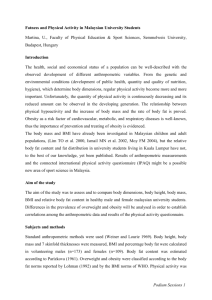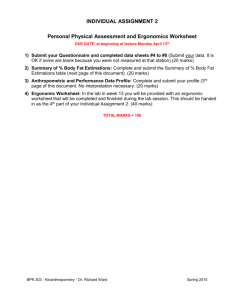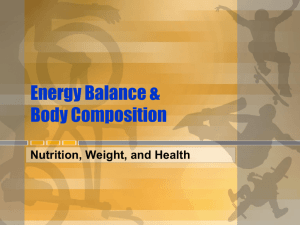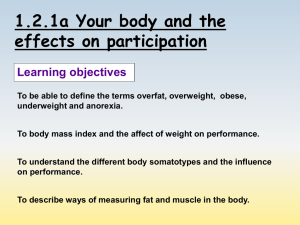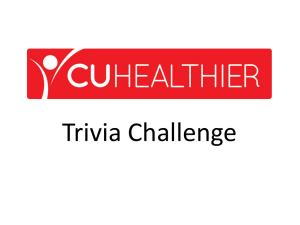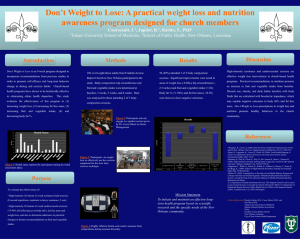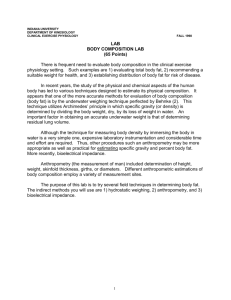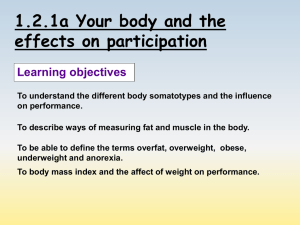Body Composition Live Show
advertisement
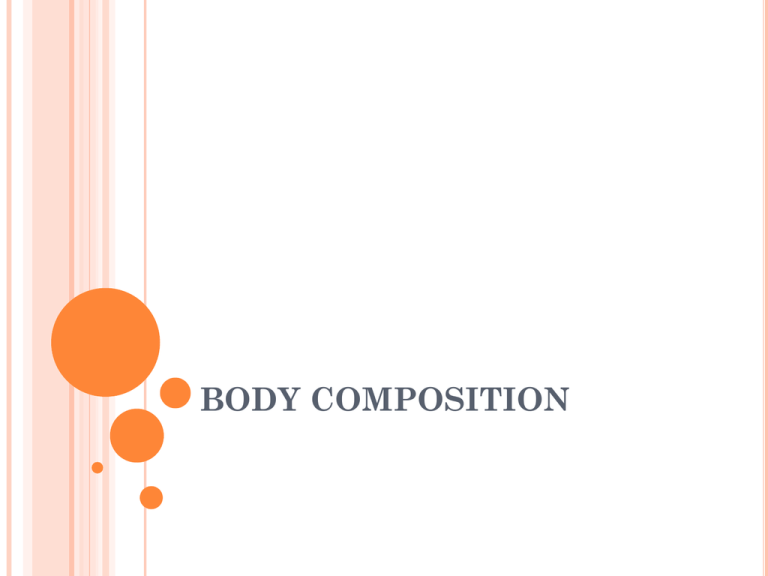
BODY COMPOSITION WHAT IS BODY COMPOSITION? How the body is made up. Split into 2 components. Fat mass refers to a persons percentage of body weight stored as fat (within adipose tissue) Lean body mass, weight of the rest of the body (bones, muscles, organs, tissue) Height and weight are not always a good indicator of body composition AVERAGE PERCENTAGE FAT MASS Sport Male % Female % Baseball 12-15 12-18 Basketball 6-12 20-27 Cycling 5-15 15-20 Field Hockey 8-15 12-18 Rowing 6-14 12-18 Swimming 9-12 14-24 Track – Runner 8-10 12-20 Track – Jumper 7-12 10-18 Track – Thrower 14-20 20-28 Triathlon 5-12 10-15 Volleyball 11-14 10-15 SIZE IN RELATION TO SPORT Every sport has an ideal size for their requirement e.g. Compare high jump to sumo what are the needs of the competitors? Weight is not that important its body composition that an athlete will be concerned about Muscles weighs around 3 times more than fat so being heavier may not be a detriment BODY MASS ASSESSMENT Hydrostatic Weighing Athlete submerged in water Difference between dry and wet weight gives percentage fat Fat is less dense and floats in water Most common and accepted method Most accurate but least available method Only estimated density of fat which varies to age, gender, race BODY MASS ASSESSMENT Bioelectrical Impendence Spectroscopy (BSI) Low safe electrical current passed through body on body fat scales Fat gives resistance to current (impedance) Results set against height and weight chart, scales then give % fat Measurement is affected by hydration It uses estimates of population so not appropriate for elite athletes with more lean muscles tissue BODY MASS ASSESSMENT Skinfold measurement Skinfold callipers measure in mm the level of fat below skin from selected body sites Sum of these measurements estimates fat % Locations vary but usually, tricep, bicep, subscapular and suprailliac Most widely used as cheap Lots of measurements so accurate Testers need to be trained and measure specific sites SKINFOLD CALLIPERS SITE METHOD TRICEP Take a vertical skinfold parallel to upper arm, halfway between the shoulder and the elbow SUBSCAPULA Take a diagonal skinfold across the back, just below the shoulder blade BICEP Take a vertical skinfold halfway between the elbow and the top of the shoulder on the front of the upper arm SUPRAILIAC Take a diagonal skinfold along the line of the iliac crest just above the hip bone PICTURE BODY MASS INDEX (BMI) Measure of weight against height Weight in Kg’s / Height in Metres Squared Men range 20.1-25.0 Women range 18.5-23.8 Does not directly measure fat but is correlated to body composition Better estimate to overweight/obesity than other methods Not suitable, for young, elderly, pregnant or athletes Athletes heavy muscles mean this is disproportionate Used a government standard test for health BMI SCALE Below 18.5 18.5-24.9 25-29.9 30-34.9 35+ Underweight Normal Overweight Obese Very obese Calculate this BMI Weight 124 KGs Height 1.96 m 1.96 x 1.96 = 3.84 m2 124 / 3.84 = 32.3 BMI JONAH LOMU OVERWEIGHT AND OBESITY Occur as a result of an imbalance between energy intake and energy expenditure If energy intake is greater than expenditure weight will increase However increasing muscle mass will also will also increase weight! ENERGY EXPENDITURE Basal Metabolic Rate (BMR) The lowest amount of energy required for minimum energy expenditure at normal rest levels (after 8hrs sleep and 12 hrs fasting) Resting Metabolic Rate (RMR) Does not include the measure of sleep so is generally used more frequently AN AVERAGE DAY 60-75% is RMR 20-30 Physical activity Rest energy used when eating, absorbing and digesting food (thermic effect) Add all 3 to get Body's Total Metabolic Rate ENEGY INTAKE On average men 2550 calories, women 1940 per day. Varies depending on? Lifestyle, age, height, weight, activity, body composition. A balanced diet looks like this (%’s) 10-15 protein No more than 30 fat 55-60 Carbohydrate CALORIE INTAKE Obviously the balance between energy intake and energy expenditure determines your total body weight Balance of the 5 a day? Find these out Depending on your diet calories can come from proportionally the 3 energy fuels, carbs, fats, proteins HEALTH IMPLICATIONS Diabetes Cancer Cardio-vascular disease Joint stress psychological harm Under performance INFO FOR EXTENDED QUESTIONS Huge increase in past 10 years Britons amongst heaviest in Europe By 2050 60% men, 50% women clinically obese Only 5% of children walk to school 80% 20 years ago Cost of obesity to UK society by 2050 £50 Billion Obesity causes 18 sick days per year EFFECTS OF PHYS ACT. ON BODY COMP Increase activity means increased number of calories burned Increased calorie burn even when activity has stopped post-exercise Increases lean body tissue which burns more calories Exercise increases the mobilisation of fats as energy fuel Therefore increase RMR when even at rest
